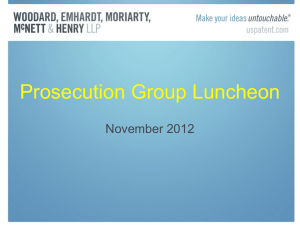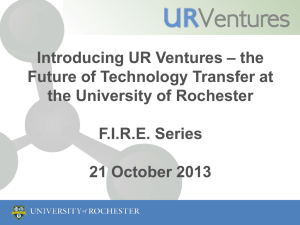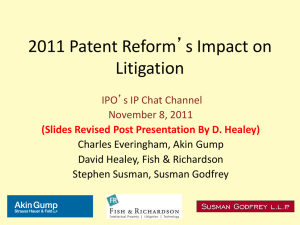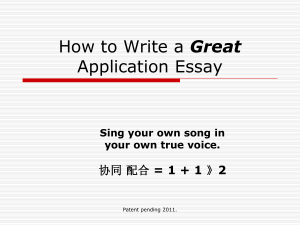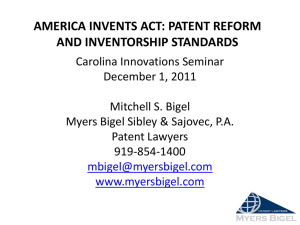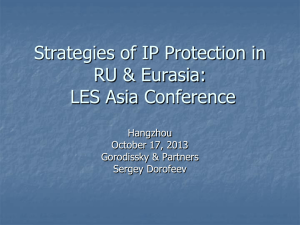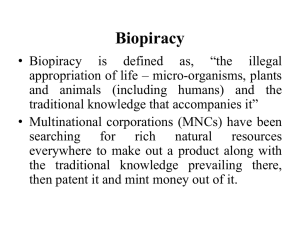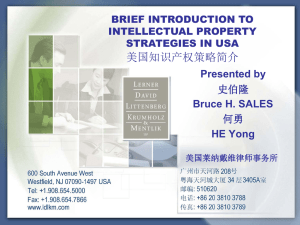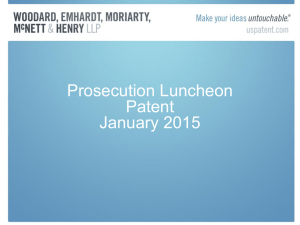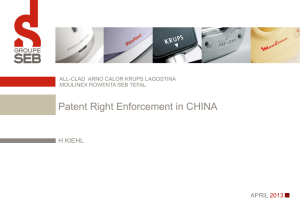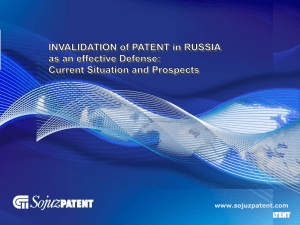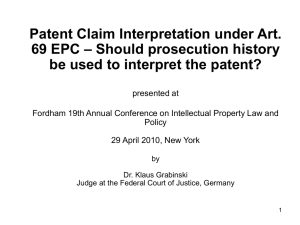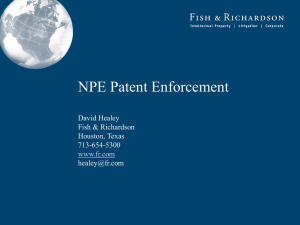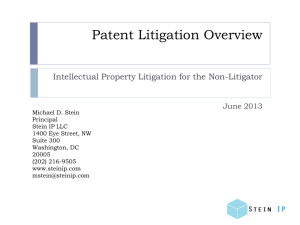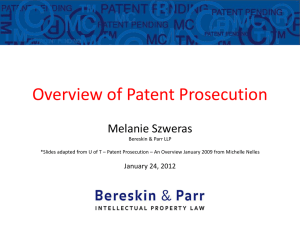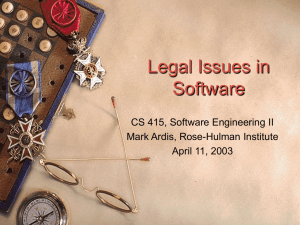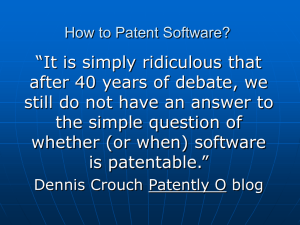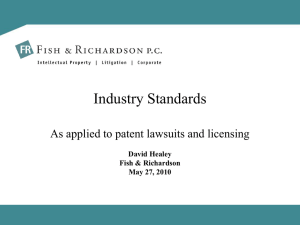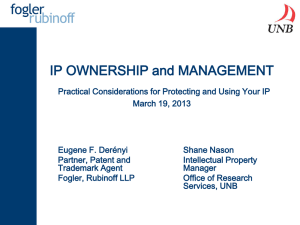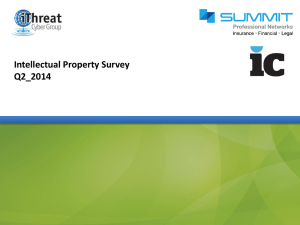Supplemental examination
advertisement
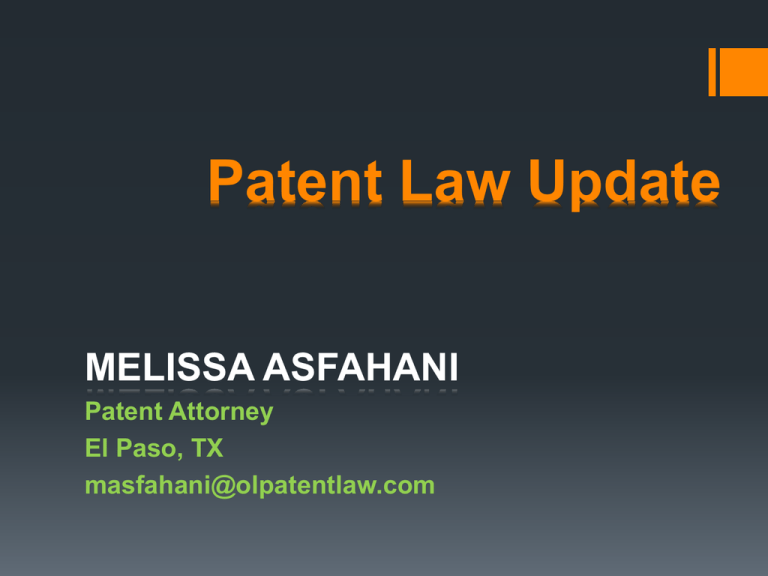
Patent Law Update MELISSA ASFAHANI Patent Attorney El Paso, TX masfahani@olpatentlaw.com Disclaimer The following presentation is provided for informational purposes only and should not be construed as legal advice for your particular legal needs. Always consult an attorney for advice pertaining to your specific business and intellectual property needs. All images and references to trademarked, copyrighted, and/or patented material in this presentation is for informational and educational purposes only. PATENT Utility Patent - Protects concepts, high level ideas, inventions. Design Patent – Protects ornamental design Plant Patent PATENT PATENT Search – USPTO databases Provisional Patent Application – good for ONE year Non-Provisional Patent Application – long examination process USPTO Rejections-Prosecution Issuance That’s all very interesting… But how does IP help my research? Why should I invest in protecting my IP? BUNDLE OF IP ASSETS A marketing tool A source of revenue through licensing/acquisition A crucial component of franchising agreements Useful for obtaining banks or third party financing A valuable business asset BUSINESS AND YOUR IP Be proactive: Invest in protecting your bundle of business assets. Be vigilant: Watch for potential infringers – license, acquire Be assertive: Protect your business assets America Invents Act On September 16, 2011, President Obama signed into law the “America Invents Act” which makes sweeping changes to the US patent system. America Invents Act Congress’s primary goals were to further enhance opportunities for innovation and entrepreneurial investment, to better harmonize U. S. patent laws with those of other countries, and to streamline patent office procedures. Over the next 18 months, the US patent laws will change so that by the spring of 2013, there will be new issues and new proceedings for patent practitioners, inventors and businesses to consider. Substantive patent law changes effective March 16, 2013 America Invents Act The most important of these new issues and procedures from the America Invents Act are: Moving to a “first-to-file” system: The United States has always had a “first-to-invent” system, meaning that deciding whether an invention was new or not obvious involved determining the state of the art at the time the invention was conceived, not at the time the application was filed. Most other patent systems around the world consider the state of the art when the application was filed. An applicant will be entitled to a patent unless “the claimed invention was patented, described in a printed publication, or in public use, on sale, or otherwise available to the public before the effective filing date of the claimed invention.” “First-to-File” System One year grace period retained Even though system becomes first-to-file, still have one year prior to public disclosure as a grace period for filing application. Publication prior to filing application: Need to file patent application within one year Could affect foreign patent rights An early public disclosure by the inventor can prevent a later disclosure or application of another from barring the patentability of the inventor’s subsequent application directed to the earlierdisclosed subject matter and filed within the grace period. “First-to-File” System File Provisional Patent Application Prior to Any Public Disclosure Protecting the Applicant's rights domestically and abroad Still allowing for later, fast publication to get the Applicant’s art on record against its competitors. America Invents Act Assignee prosecution opportunities: Traditionally, a patent application is filed on behalf of an inventor, and the resulting patent is issued in the inventor’s name. Inventors can assign (e.g. sell or transfer) their patent rights to a third party such as a business or another person, for example the inventor’s employer. Traditionally these third parties (assignees) could move the application through the Patent Office with certain authorizations from the inventor. The new law still requires the original inventor be identified. However, if the inventor is required to assign the invention to a third party, the assignment can authorize the third party to take control the application as it moves through the Patent Office. The resulting patent would issue in the third party’s name. America Invents Act Personal infringement defense based on prior use. The act provides a broader “prior use” defense, for use in cases in which a business is using a process or machine as part of a process, and has been doing so for more than one year prior to the effective filing date of a patent that would cover the process or machine. The defense is personal to the user, and can only be transferred with the business to which the process or machine relates. The defense addresses situations in which private first-users have been accused of infringement of another’s later-filed patent, where the non-public first use cannot be used to invalidate the patent. America Invents Act Post-grant review of patents: Perhaps the most anticipated aspect of the new act creates proceedings in the Patent Office to challenge issued patents. Two separate proceedings are created by the new law: The “inter partes” review permits allegations of invalidity over prior art. The “post-grant” review permits allegations of invalidity on any ground in the statute, and must be filed within nine months of the patent’s issuance. America Invents Act Supplemental examination: The act provides a procedure for supplemental examination of a patent by the owner. The supplemental examination is not a re-examination. However, if the Patent Office discovers a substantial new question of patentability during a supplemental examination, a re-examination will be ordered using the current reexamination procedure. A supplemental examination can be used to “cure” what might be inequitable conduct in the original prosecution, if the previously unconsidered or incorrect information was considered or corrected in the supplemental examination. America Invents Act Micro Entity Filing fees: In addition to the existing large entity and small entity patent fees, the act creates a “micro entity” fee structure, which will most commonly be used by independent inventors. 75% Discount on Large Entity Fees A “micro entity” is any small entity that has filed no more than four applications, and has an income that is less than certain specified limits. Micro entities are charged significantly lower fees that are only 25% of the large entity fee (i.e. $250 for filing, examination and search fees). America Invents Act Prioritized Examination Prioritized examination of a non-provisional application for an original utility or plant patent can now be requested for technologies important to American competitiveness However, this carries a fee of $4,800. America Invents Act Satellite Offices and Pro Bono Congress requires the USPTO to establish three satellite offices within three years of the date of enactment (i.e., by September 16, 2014). Increase outreach activities, enhance employee retention, improve recruiting, decrease the application backlog, and improve examination quality. Dallas, San Jose, Detroit The AIA directs the USPTO to work with intellectual property law associations across the country in order to establish pro bono programs for financially under-resourced inventors and small businesses. A pilot program in Minnesota was launched in June of 2010 to provide legal services to help such individuals and businesses obtain solid patent protection. Thank you!

